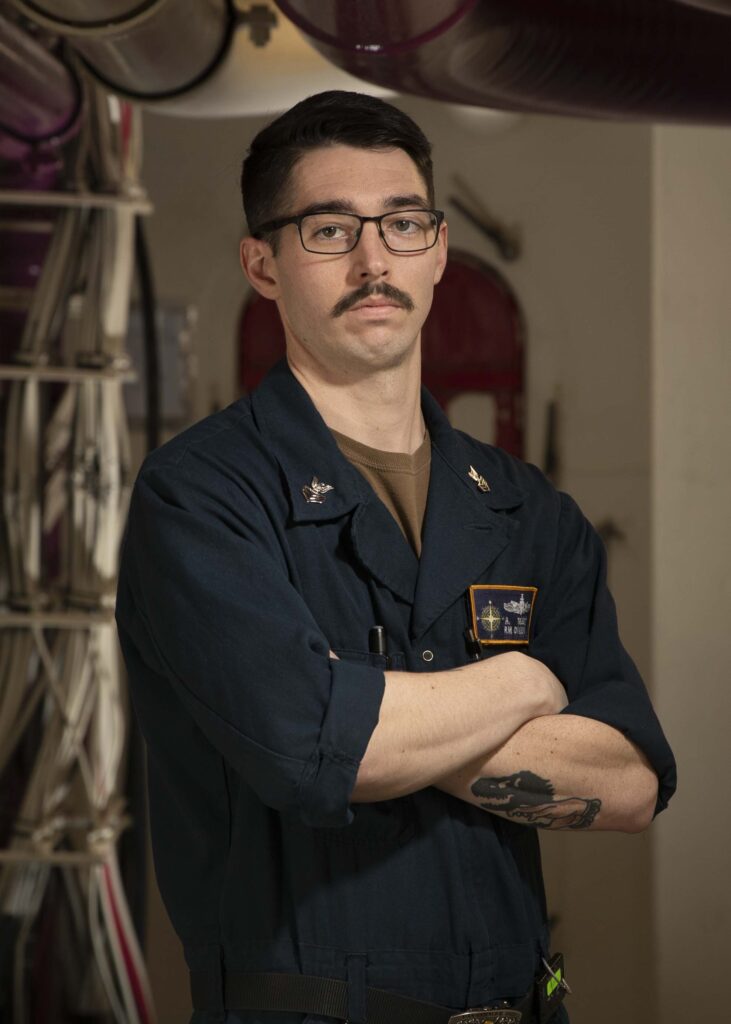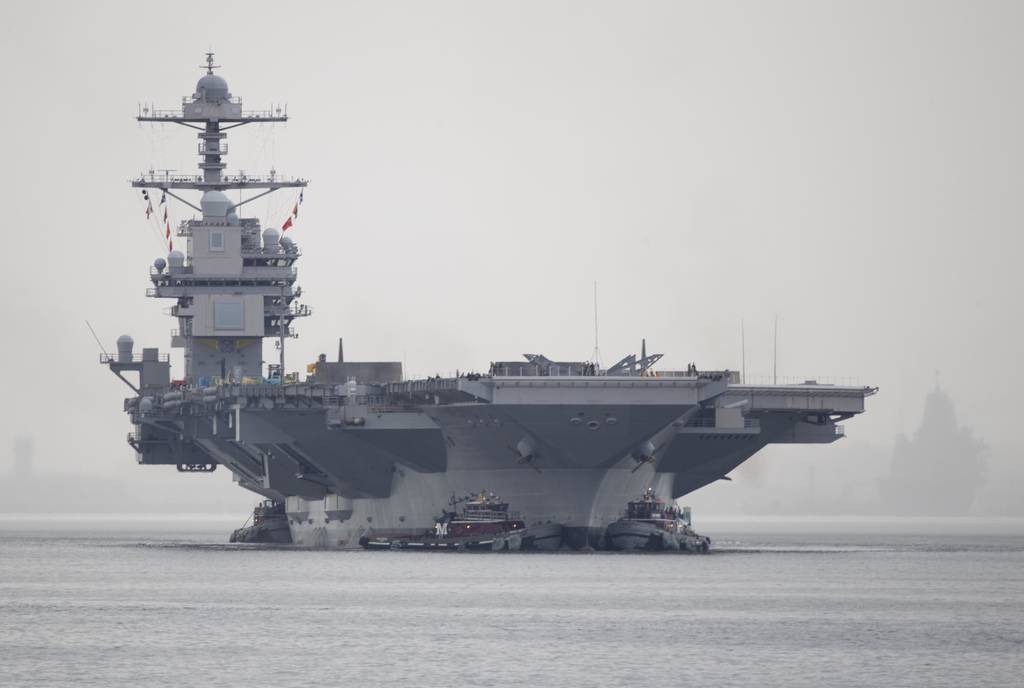By Mass Communication Specialist 1st Class Patricia Rodriguez, Navy Office of Community Outreach

Petty Officer 1st Class Alex Talbot of Brentwood. Photo by Mass Communication Specialist Seaman Manvir Gill
NORFOLK, Va. – Petty Officer 1st Class Alexander Talbot, a native of Brentwood, California, serves the U.S. Navy aboard one of the world’s largest warships, the U.S. Navy aircraft carrier USS Gerald R. Ford.
Talbot joined the Navy six years ago. Today, he serves as a machinist’s mate (nuclear).
“I joined the Navy because I wanted to see the world and have an opportunity to get out and make a difference,” said Talbot.
Growing up in Brentwood, Talbot attended Liberty High School and graduated in 2011. Today, Talbot relies upon skills and values similar to those found in Brentwood to succeed in the military.
“When I was growing up, I was on the wrestling team for six years,” said Talbot. “It taught me to have a strong work ethic and drive. It taught me to tackle any challenge placed in front of me. It also helped me understand how to achieve my own goals but also be part of a team.”
These lessons have helped Talbot while serving in the Navy.
Aircraft carriers provide unique capabilities and survivability. They are a powerful exhibition of the American Navy’s legacy of innovation, technological evolution, and maritime dominance, according to Navy officials.
USS Gerald R. Ford (CVN 78) represents the first major design investment in aircraft carriers since the 1960s. The ship is engineered to support new technologies and a modern air wing essential to deterring and defeating near-peer adversaries in a complex maritime environment. Ford delivers a significant increase in sortie generation rate, approximately three times more electrical generation capacity, and a $4 billion reduction in total life-cycle cost per ship, when compared to a Nimitz-class aircraft carrier. Once deployed, the Ford-class will serve as the centerpiece of strike group operations through the 21st century, supporting a host of evolving national strategic objectives. When the air wing is embarked, the ship carries more than 70 attack fighter jets, helicopters and other aircraft, all of which take off from and land from FORD’s state-of-the-art Electromagnetic Aircraft Launch System (EMALS) and Advanced Arresting Gear (AAG). With nearly 5,000 Sailors serving aboard, Ford is a self-contained mobile airport.

The aircraft carrier Gerald R. Ford departs Naval Station Norfolk to transit to Newport News Shipyard in support of its planned incremental availability, a six-month period of modernization, maintenance and repairs, on Aug. 20, 2021. Photo by MC1 William Spears/U.S. Navy) Source: DefenseNews.com
Aircraft carriers are often the first response to a global crisis because of their ability to operate freely in international waters anywhere on the world’s oceans. Carrier strike groups have the unique advantage of mobility, making them far more strategically advantageous than fixed-site bases. No other weapon system can deploy and operate forward with a full-sized, nuclear-powered aircraft carrier’s speed, endurance, agility, and the combat capability of its air wing.
“I could not be more proud of our sailors; this crew displayed a phenomenal amount of resiliency and proficiency during each phase of our operational development,” said Capt. Paul Lanzilotta, Ford’s commanding officer. “The crew’s efforts are what make Warship 78 so great, and I can’t wait to be a part of what this mighty warship and her crew achieve in 2022.”
Since USS Langley’s commissioning 100 years ago, the nation’s aircraft carriers, such as Ford, and embarked carrier air wings have projected power, sustained sea control, bolstered deterrence, provided humanitarian assistance and disaster relief, and maintained enduring commitments worldwide. Gerald R. Ford represents a generational leap in the aircraft carrier’s capacity to project power on a global scale.
“The aircraft carrier is our U.S. Navy’s centerpiece, our flagship, and a constant reminder to the rest of the world of our enduring maritime presence and influence,” said Rear Adm. James P. Downey, USN, Program Executive Officer (PEO) Aircraft Carriers. “These ships touch every part of our Navy’s mission to project power, ensure sea control, and deter our adversaries.”
According to DefenseNews.com, “The U.S. Navy has promised a first deployment for its new aircraft carrier Gerald R. Ford by this fall — but that deployment won’t be a typical one…The carrier and its strike group will operate on both sides of the Atlantic Ocean alongside a long list of foreign navies…But the operations will be outside the typical Global Force Management-dictated deployment in support of the joint force.”
Serving in the Navy means Talbot is part of a team that is taking on new importance in America’s focus on rebuilding military readiness, strengthening alliances and reforming business practices in support of the National Defense Strategy.
“If we didn’t have a strong naval presence out there, I don’t think there would be as much deterrence,” said Talbot. “Other countries would try to threaten the peace of other nations without consequences. I think a lot of people sleep easier knowing we’re out here.”
With more than 90 percent of all trade traveling by sea, and 95 percent of the world’s international phone and internet traffic carried through fiber optic cables lying on the ocean floor, Navy officials continue to emphasize that the prosperity and security of the United States is directly linked to a strong and ready Navy.
Talbot and the sailors they serve with have many opportunities to achieve accomplishments during their military service.
“I was selected to be the engine room supervisor during full ship shock trials,” said Talbot. “That is where they used 40,000 pounds of explosive to test how the ship would respond and handle battle damage. Out of 75 different operators, I was only one of two who were selected. My department knew that while I was on watch, the reactor plant would operate safely no matter what.”
As Talbot and other sailors continue to train and perform missions, they take pride in serving their country in the United States Navy.
“Serving in the Navy has given me an opportunity to challenge myself every day and be a part of something bigger,” added Talbot. “I enjoy serving alongside some great friends and being around some of the greatest people I have ever met.”

Leave a Reply